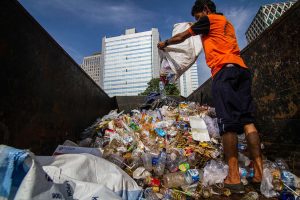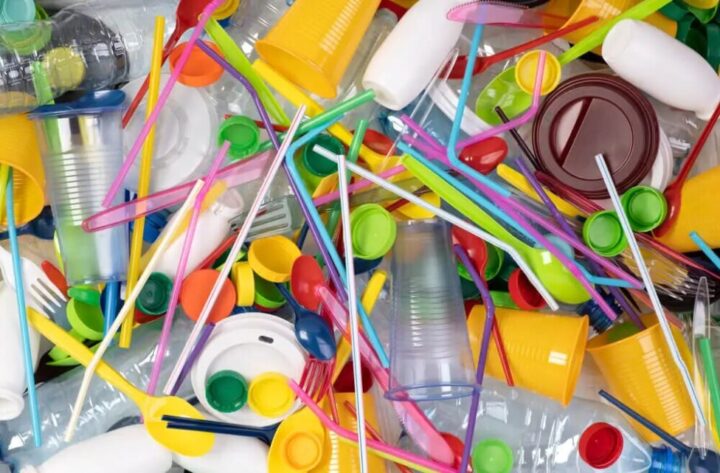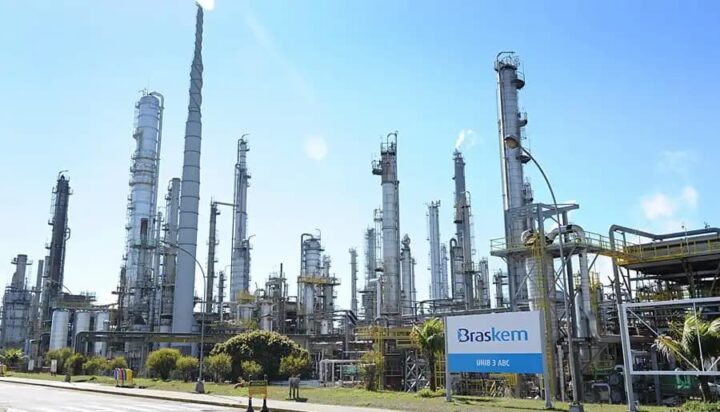
In a Mexican city with buildings that reflect its level of modernization, a truck collects waste, mainly plastic, ignoring higher standards of care for health and the environment. Plastic garbage is just the tip of a serious social and environmental problem in Latin America and the Caribbean. CREDIT: Greenpeace
By Humberto Márquez
CARACAS, Jul 24 2023 – Countries in Latin America and the Caribbean have made progress towards partial regulations to reduce plastic pollution, but the problem is serious and environmental activists are calling for regulations in the entire chain of production, consumption and disposal of plastic waste.
The release of plastic waste into the environment “is the tip of the iceberg of a problem that begins much earlier, from the exploitation of hydrocarbons, to the transport and transformation of these precursors of an endless number of products,” Andrés del Castillo, a Colombian expert based in Switzerland, told IPS.”That is why our main call is for an immediate moratorium on increased plastics production, followed by a phased out reduction in supply, and complemented by other crucial measures such as reuse and landfill systems.” — Andrés del Castillo
Ecuadorian biologist María Esther Briz, an activist with the international campaign Break Free From Plastic, said “plastic pollution in our countries is not on its way to becoming a big problem: it already is.”
“From the extraction of raw materials, since we know that 99 percent of plastic is made from fossil fuels – oil and gas – plus the pollutants that are released during the transformation into resins and in consumption, and in the more well-known phase of when they become waste, our region is already very much affected,” the activist told IPS from the Colombian city of Guayaquil.
Plastic production in the region exceeds 20 million tons per year – almost five percent of the global total of 430 million tons per year – and consumption stands at 26 million tons per year, according to the Global Alliance for Incinerator Alternatives (GAIA), a coalition of 800 environmental organizations.
In the region, the largest installed production capacity is in Brazil (48 percent), followed by Mexico (29 percent), Argentina (10 percent), Colombia (8.0 percent) and Venezuela (5.0 percent).
The average annual consumption in Latin America and the Caribbean is about 40 kilos per inhabitant, and each year the region throws 3.7 million tons of plastic waste into rivers, lakes, seas and oceans, according to the United Nations Environment Program (UNEP).
Del Castillo, a senior lawyer at the Center for International Environmental Law (CIEL), warned that “if the trend is not reversed, by 2050 plastic production will reach 1.2 billion million tons annually. Paraphrasing (famed Colombian author of One Hundred Years of Solitude) Gabriel García Márquez, that is the size of our solitude.”
“That is why our main call is for an immediate moratorium on increased plastics production, followed by a phased out reduction in supply, and complemented by other crucial measures such as reuse and landfill systems,” del Castillo said from Geneva.

Volunteers from Peru’s Life Institute for Environmental Protection clean up plastic garbage washed up on the coast near Lima. In the waters surrounding cities, as well as in the oceans, discarded plastic waste that is not reused or recycled is added to other forms of pollution, severely affecting nature, including species and the landscape. CREDIT: IPMAV
Fearsome enemy
The plastic life chain is an enemy to health due to the release of more than 170 toxic substances in the production process of the raw material, in the refining and manufacture of its products, in consumption, and in the management and disposal of waste.
Once it reaches the environment, in the form of macro or microplastics, it accumulates in terrestrial and aquatic food chains, pollutes water and causes serious damage to human health, to animal species – such as aquatic species that die from consuming or being suffocated by these products – and to the landscape.
It also accounts for 12 percent of urban waste. UNEP estimates the social and economic costs of global plastic pollution to be between 300 billion dollars and 600 billion dollars per year.
It also affects the climate: the world’s 20 largest producers of virgin polymers employed in single-use plastics, led by the oil companies Exxon (USA) and Sinopec (China), generate 450 million tons a year of planet-warming greenhouse gases, almost as much as the entire United Kingdom.
And prominent villains are single-use plastics, such as packaging, beverage bottles and cups and their lids, cigarette butts, supermarket bags, food wrappers, straws and stirrers. Of these, 139 million tons were manufactured in 2021 alone, according to an index produced by the Australian Minderoo Foundation.
After alarm bells went off at the United Nations, the Intergovernmental Negotiating Committee on plastic pollution, composed of 175 countries, was created. It held its first two meetings last year, in Montevideo and Paris, and will hold its third in November in Nairobi, in a process aimed at drafting a binding international treaty on plastic pollution.
As if the boom in the production, consumption and improper disposal of plastics were not enough, the Latin American region is also importing plastic waste from other latitudes.
Studies by GAIA and the Peruvian investigative journalism website Ojo Público reported that in the last decade (2012-2022) Mexico, Ecuador, Peru, Chile and Colombia received more than one million tons of plastic waste from different parts of the world.
Although it is claimed that plastic waste is sold to be recycled into raw material for lower quality products or textiles, this rarely happens and it ends up adding to the millions of tons that go into landfills every year.
“We cannot even deal with our own waste and yet we are importing plastic garbage from other countries, often with very little clarity and transparency, so there is no traceability of what is imported under the pretext of recycling,” Briz complained.

Single-use plastics, more than a third of global production and ubiquitous in everyday life, are seen as the main villains in the entire plastics business chain, and Latin American and Caribbean countries are moving towards banning them altogether or at least limiting production and use. CREDIT: Goula
Laws and regulations are on their way
On the other side of the coin, in 2016 Antigua and Barbuda became the first country in the region to ban single-use plastic bags, and it has gradually expanded the ban to include polystyrene food storage containers, as well as single-use plates, glasses, cutlery and cups.
Since then, 27 of the 33 countries of Latin America and the Caribbean have enacted national or local laws to reduce, ban or eliminate single-use articles and, in some cases, other plastic products.
“There is a wide range: countries that already have strong rules to regulate plastics, especially single-use plastics, and they are applied. Others have very good regulations but they are not enforced. In others there are no regulations, and there are countries where nothing is happening,” Briz said.
In Argentina a 2019 resolution by the Ministry of Environment and Sustainable Development covers the life cycle of plastic (production, use, waste and pollution reduction) and a 2020 law bans cosmetic and personal hygiene products containing plastic microbeads.
Belize, Chile, Colombia, most Mexican states and Panama have passed regulations to progressively ban or limit the consumption of single-use plastics, as have Brazilian cities such as Rio de Janeiro and São Paulo. But in some cases there are doubts as to whether these provisions are effectively enforced.
Brazil has had a National Plan to Combat Marine Litter since 2019, which, however, has not yet been implemented. Costa Rica also has a National Marine Litter Plan, which seeks to reduce waste with the support of the communities.
Ecuador is turning the Galapagos Islands into a plastic-free archipelago, and phased out plastic bags, straws, “to-go” containers and plastic bottles in 2018.
Fences, including those made from recovered plastic waste, are being installed in rivers in Guatemala, Honduras, Panama and the Dominican Republic to collect plastic waste and prevent it from being washed out to sea.
In Guatemala, Castillo noted, the municipality of San Pedro La Laguna, in the Lake Atitlán basin, was a pioneer, banning sales of straws and plastic bags in 2016, and the city government won lawsuits in court over the ordinance. The example is spreading throughout the country.

View of a petrochemical plant of the Brazilian giant Braskem. Environmentalists’ demands for a halt to the expansion of plastics production focus on states in Mexico and Brazil, which have the largest petrochemical facilities in the Latin American region. CREDIT: Braskem
From landfills to petrochemicals
Del Castillo, the Ecuadorian expert, said that “apart from initiatives of a voluntary nature, regional action plans, and the regulation of single-use plastic products, the ongoing negotiation of an international treaty promises to be the path that has been chosen to put an end to plastic pollution.”
The treaty should cover “all emissions and risks from plastics during production, use, waste management and leakage,” del Castillo said, but “we don’t have to wait for the treaty to act: States can already say ‘No to the expansion of virgin plastics production’.”
The MarViva Foundation, which fights marine pollution in Colombia, Costa Rica and Panama, argues that “the best way to manage single-use plastic waste is not to create it,” and advocates discouraging the production, use and consumption of these materials.
But in the face of such proposals, “one of the biggest obstacles has to do with the economic power of the petrochemical industry, which refuses to reduce production. In Latin America, the largest producers of plastics are the petrochemical companies of Mexico and Brazil,” said Briz, the Ecuadorian biologist.
“Plastic is a cheap product, since its environmental and social costs are not taken into account, and while the cost of production and distribution is low, the cost for the health of people and the environment is not,” said the activist.
In short, for activists, an approach based only on recycling and bans will be of limited scope until a moratorium is imposed on the expansion of plastics production, with a global market worth 600 billion dollars a year and which at the current rate could triple in the next two decades.